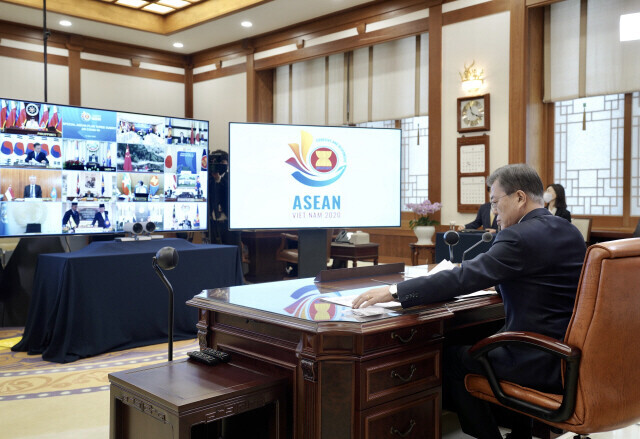hankyoreh
Links to other country sites 다른 나라 사이트 링크
US-China tensions in S. China Sea likely to be contentious topic in ASEAN’s multilateral meetings

As the South China Sea becomes the subject of saber-rattling between the US and China, the Association of Southeast Asian Nations (ASEAN) will be hosting a series of multilateral meetings on Sept. 9. The meetings will be held online, because of concerns about COVID-19, and are likely to feature a fierce tug-of-war between the US and China, as each country attempts to recruit ASEAN members to its own cause.
South Korea’s Ministry of Foreign Affairs (MOFA) said on Sept. 7 that Foreign Minister Kang Kyung-wha will be attending a meeting with the foreign ministers of ASEAN, another meeting with those diplomats plus the foreign ministers of China and Japan, and the East Asia Summit, all taking place on Sept. 9. Kang will also attend the ASEAN Regional Forum (ARF) on Sept. 12, MOFA said.
The original plan was to hold these meetings in Vietnam, but the prolongation of the COVID-19 pandemic led the countries involved to opt for digital meetings instead. Since the ARF is the only multilateral deliberative body in which North Korea takes part, the event attracts keen attention each year. There hasn’t yet been confirmation about how North Korea will participate this year.
These multilateral meetings are scheduled to take place as the US and China hold belligerent military exercises in the South China Sea, following China’s crackdown on dissent in Hong Kong. The timing of the meetings makes it likely that sparks will fly between the two powers.
In June and July, the US carried out a large-scale military exercise involving two aircraft carriers in the South China Sea, which is surrounded by ASEAN member states. That prompted China on Aug. 26 to test launch four of its Dong Feng-21D ballistic missiles capable of striking US aircraft carriers. The test leaves no doubt that China means to check the free movement of American carriers.
US unveils idea of upgrading Quad framework into multilateral security alliance to counter ChinaOn Aug. 31, US Deputy Secretary of State Stephen Biegun unveiled the idea of upgrading the Quadrilateral Security Dialogue between the US, India, Australia, and India into a multilateral security alliance that would serve as an Asian equivalent of the North Atlantic Treaty Organization (NATO). The Quad, as it is called, is a concrete manifestation of the aims of the Indo-Pacific Strategy, the US’ strategy of containing China. China is expected to counter these moves by offering to provide vaccination for COVID-19 and infrastructure investment.
Trapped between these two major powers, the South Korean government tried to remain noncommittal: “We are pursuing regional cooperation with both countries, while affirming that the US’ Indo-Pacific Strategy and our New Southern Policy have many things in common.”
“These are multilateral conferences in which 10 or 20 countries take part, which means they won’t be dominated by the US or China. We expect that several issues will be discussed in addition to the South China Sea,” said a MOFA official.
By Kim Ji-eun and Gil Yun-hyung, staff reporters
Please direct comments or questions to [english@hani.co.kr]

Editorial・opinion
![[Guest essay] Maybe Korea’s rapid population decline is an opportunity, not a crisis [Guest essay] Maybe Korea’s rapid population decline is an opportunity, not a crisis](https://flexible.img.hani.co.kr/flexible/normal/500/300/imgdb/original/2024/0430/9417144634983596.jpg) [Guest essay] Maybe Korea’s rapid population decline is an opportunity, not a crisis
[Guest essay] Maybe Korea’s rapid population decline is an opportunity, not a crisis![[Column] Can Yoon steer diplomacy with Russia, China back on track? [Column] Can Yoon steer diplomacy with Russia, China back on track?](https://flexible.img.hani.co.kr/flexible/normal/500/300/imgdb/original/2024/0430/1617144616798244.jpg) [Column] Can Yoon steer diplomacy with Russia, China back on track?
[Column] Can Yoon steer diplomacy with Russia, China back on track?- [Column] Season 2 of special prosecutor probe may be coming to Korea soon
- [Column] Park Geun-hye déjà vu in Yoon Suk-yeol
- [Editorial] New weight of N. Korea’s nuclear threats makes dialogue all the more urgent
- [Guest essay] The real reason Korea’s new right wants to dub Rhee a founding father
- [Column] ‘Choson’: Is it time we start referring to N. Korea in its own terms?
- [Editorial] Japan’s rewriting of history with Korea has gone too far
- [Column] The president’s questionable capacity for dialogue
- [Column] Are chaebol firms just pizza pies for families to divvy up as they please?
Most viewed articles
- 1First meeting between Yoon, Lee in 2 years ends without compromise or agreement
- 2Under conservative chief, Korea’s TRC brands teenage wartime massacre victims as traitors
- 3Months and months of overdue wages are pushing migrant workers in Korea into debt
- 4[Guest essay] Maybe Korea’s rapid population decline is an opportunity, not a crisis
- 5[Column] Can Yoon steer diplomacy with Russia, China back on track?
- 6‘We must say no’: Seoul defense chief on Korean, USFK involvement in hypothetical Taiwan crisis
- 7Dermatology, plastic surgery drove record medical tourism to Korea in 2023
- 8After election rout, Yoon’s left with 3 choices for dealing with the opposition
- 9Two factors that’ll decide if Korea’s economy keeps on its upward trend
- 10[Column] Behind factional animus of Korean politics, victim mentality festers